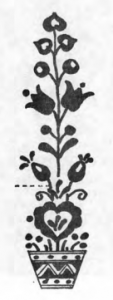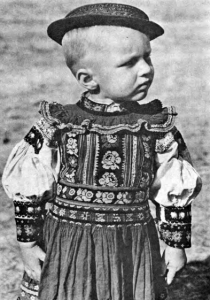Introduction
The two million or so Slovaks now in the United States represent barely one percent of the nation’s population. Their story in America is an especially illuminating one for scholarly inspection, for the Slovak experience is like a crystal prism that casts light in many directions, at many angles. Slovakia is a wine-drinking land, with many connections to Mediterranean peoples. Both through the Czechs and directly, it has many connections with Germanic peoples; for generations, the Slovak city Bratislava was a symbolic center of the Austro-Hungarian Empire, the city of coronations. By language, the Slovaks are kin to the Poles to the north, the Russians to the East, and the Yugoslavs to the South, and the Slovak tongue is thought to be closer than any other to the matrix of Slavic languages.
As long ago as most blacks in America were slaves, most Slovaks were serfs in Europe. They lived, in addition, under the rule of foreigners different from them in race and language. They possessed few inviolable civil rights. Until the twentieth-century, the social structure of Slovakia was not far removed from the feudal period. While traditions of literacy and learning were honored, many peasants were refused education beyond the fourth or fifth year — or, in any case, could not attain it. Most were rural peoples, skilled with tools and implements of certain sorts and carriers of the crafts and arts of Central Europe. Climate and poverty had toughened them. Life at the crossroads of Europe — enduring invasions from the hordes of Attila, the advances of the Turks in medieval times, and the armored corps of Hitler’s Germany and the Soviets today — brought them contact with multiple diverse civilizations. The castles on the hills of Slovakia reflect many technical secrets and artistic flourishes learned from many cultures. In the 1880’s hunger and serious demographic changes forced nearly half the population of the eastern countries of Slovakia to emigrate elsewhere for survival. From the countries of Spiš and Velkŷ Šariš, in particular, scores of thousands fled to western Pennsylvania and eastern Ohio.
Unlike Jewish, Greek, or Rumanian immigrants, the Slovaks did not in great numbers look to higher education and the professions for their major roads of advancement in America. Relatively few went into business for themselves. Most tried to establish themselves in solid, secure jobs, struggling first of all to own their own homes. Home first, other things second, seems to have been the economic strategy of most. Professors Josef Barton and Mark Stolarik have written excellent histories of the Slovak migration to Cleveland; the former’s has been published by the Harvard University Press under the title Peasants and Strangers, and the latter’s is available from the University of Minnesota as a Ph.D. thesis.
Among chroniclers of the Slovak experience in America, readers may wish to seek out the following. Thomas Bell’s novel about the Slovaks in Braddock, Pennsylvania, Out of this Furnace, has recently been published by the University of Pittsburgh press in paperback. Andrew Cincura has done herculean work in assembling An Anthology of Slovak Literature, including works both from Slovakia and from America. Sonya Jason has written a novel about the experience of Slovak women in America, Concomitant Soldiers (available from the author in paperback at: 21165 Escondido Street, Woodland Hills, California, 91364). Paul Wilkes has recently won several prizes for his television documentary about six American families, and is now writing a history of Slovak families in America. My own books, The Rise of the Unmeltable Ethnics (Macmillan), Growing Up Slavic in America and Further Reflections on Ethnicity (available through the Jednota Press, Middletown, Pennsylvania, 17057) have tried to shed light on the immigrant experience. In 1978, Basic Books will publish my account of the Lattimer Mines massacre of 1897, in which some fifty Slavic workers, including many Slovaks, were shot down in cold blood. Many other books and pamphlets are available through the Jednota press.
In 1977, an Association of Slovak Scholars was established through the vision and energy of the young Canadian-Slovak scholar Mark Stolarik. The annual review Slovakia (Middletown, Pa., 17057) represents a forum for such scholarship, as for poets and story tellers. The Tamburitzans at Duquesne University have vast holdings in Slovak folk songs, among the thousands of the world’s folk songs collected in their archives, the best in the nation. The Immigration History Research Center at the University of Minnesota (826 Berry Street, St. Paul, Minnesota, 55114) has a motherlode of information on Slovaks in America for future exploration by scholars.
We do not know nearly as much as we should about the history of the Slovak people, whether in Slovakia or in diaspora around the world. Much work remains to be done by artists and scholars.
The purpose behind such activities should be the one value which Alexander Solzhenitsyn, the great Russian writer of our age, calls the most powerful force in the world: truth. The motive is not “pride.” The motive is truth. Human beings are fallible and wounded creatures, and so in studying history one finds not only matters of pride but also matters of shame. It is not, for example altogether happy to discover that the brief independence of the Slovak state, during the period of World War II, was won only by alliance with Hitler and the Axis Powers. In no other way could the autonomy of Slovakia been secured and, until 1944, Hitler’s armies were kept outside Slovakia. Still, the brief life of the nation was deeply shadowed by the ominous nearby presence of Hitler’s evil purpose.
The motive of the new ethnicity is truth, not pride. Yet one reason why “pride” is so much spoken of is that so many have in fact been made to feel ashamed for being what they are. Many have been looked down upon, and could not help noticing it, feeling it, internalizing it. The experience of a secret shame has been one of the most common of American experiences. To be taught how to become “American” was to be made to feel embarrassed about what was “not American” in one’s name, face, manner, style, behavior. The temptation, then, to turn to “pride” as the antidote to long-experienced shame is great. This temptation should be resisted.
Clearer knowledge about our own roots should make us more generous, larger of mind and heart, more fully and openly sympathetic to others different from ourselves. Many such differences characterize America. The most effective and profound way of unifying all of us as one great people is for each person and each group to gain more truthful and more sympathetic knowledge: both about self and about others. Knowledge alone, of course, does not save us. But knowledge can help us to break down prejudices and to go beyond simplistic assumptions; it can help us better to understand deep and hidden aspirations, longings, and fears that have grown out of hundreds of years of history. Each of us carries a thousand years of history in our behavior. It is better for that history to be appropriated consciously than for it to be repressed.
So much remains to be done. It is to be hoped that this brief history will stimulate a new generation of poets, dramatists, writers, moviemakers, historians, and scholars of every sort to prepare better histories and greater works in the future. Immigration is a voyage that lasts for many generations. Some day soon, a generation will come along that will link hands again with the culture left behind, and in a kind of circle complete the fragmentary journey so far, and so painfully, traversed.
Michael Novak


